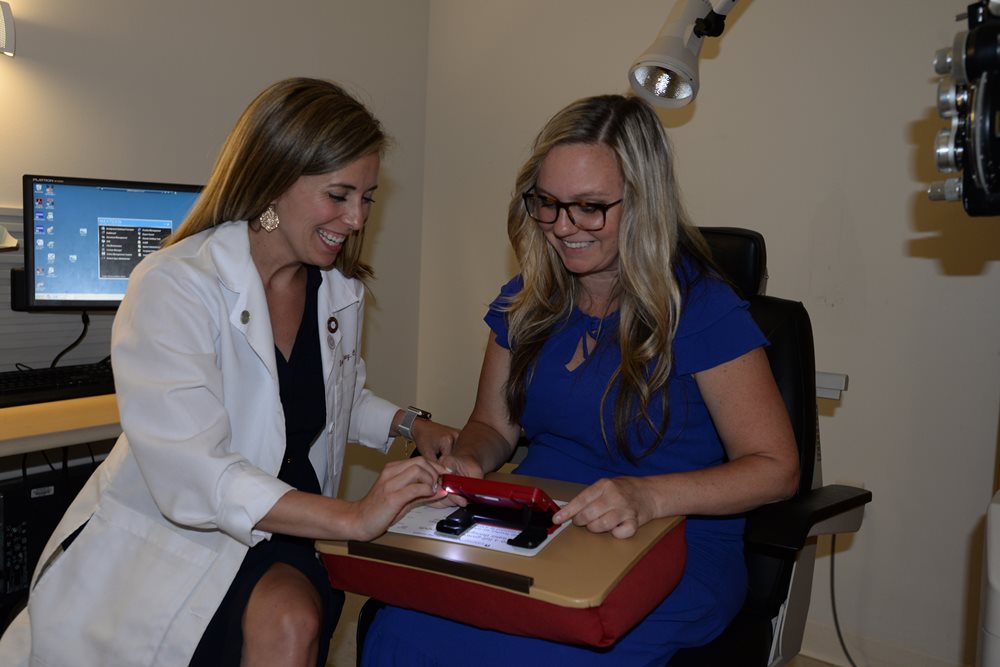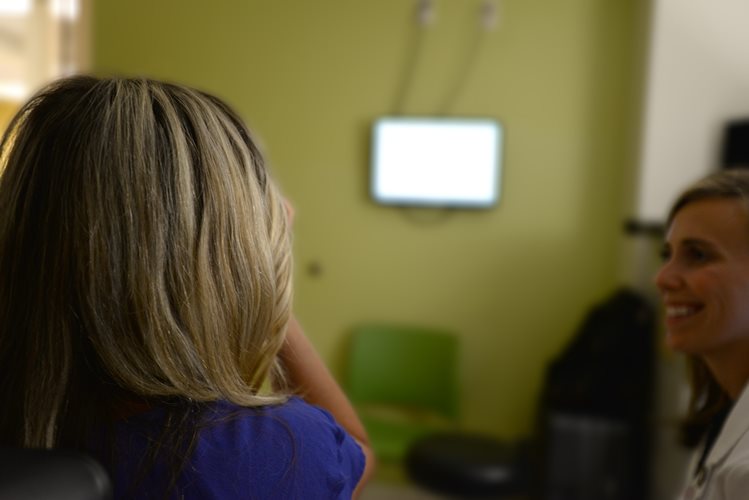Maintaining Independence with Low Vision Aids
 Kim Harris is an Emergency Room nurse at a major Philadelphia hospital. She’s also a mother of two young children, ages six and three. And, Kim is living with Stargardt’s disease.
Kim Harris is an Emergency Room nurse at a major Philadelphia hospital. She’s also a mother of two young children, ages six and three. And, Kim is living with Stargardt’s disease.
Stargardt's disease also called fundus flavimaculatus or Stargardt's macular dystrophy (SMD, affects approximately one in 10,000 people and is characterized by central vision loss. Central vision loss occurs, while peripheral vision usually is retained. Symptoms of Stargardt's disease can include blurry or distorted vision, an inability to see in low lighting and difficulty recognizing familiar faces.
Harris starting wearing glasses in her early 20s as her vision wasn’t as sharp but it wasn’t until she was 26 years old, during an annual eye exam that the doctor saw something on her retina that warranted further examination. He suggested she follow up with a retina specialist. In the meantime, she had her primary care physician conduct a complete physical to rule out any underlying medical problem, such as diabetes, which could affect her retina. Her physical checked out fine. But as soon as she sat in the retina specialist’s chair, he knew. Even without the official genetic testing, he was pretty sure she had Stargardt’s.
Harris was living in the Lancaster, PA area when she was first diagnosed. She has since moved back to Philadelphia and after research and recommendations from the Stargardt’s support group, switched to a University of Pennsylvania retina specialist. “Though my vision was still very stable, I had a lot of anxiety,” she noted. “Even though I wasn’t really ready for Low Vision services, my doctor recommended to me a low vision doctor who had me reach out to a vocational rehab, the Bureau of Blindness and Visual Services (BBVS) which works closely with the Low Vision Program and The Eye Institute (TEI). That’s how I first learned of TEI’s program. When I came here I loved it.”
Harris has been coming to the William Feinbloom Vision Rehabilitation Center, housed at TEI for almost two years. She has been working with Dr. Erin Kenny, chief of the Feinbloom Center, and Dawn Ciccarone, MS, OTR/L, low vision therapist. The last few years her central vision has been more significantly affected in her right eye causing her to have difficulties with everyday life activities. “The Low Vision service has been life-changing, providing me with so much insight into what is available for people with low vision. There are so many different aids which make life easier and decrease anxiety. The doctors and therapists take the time, sit with me and show me the different assistive devices available. It can be overwhelming but time is not an issue,” Harris said. “The work they do is amazing. I have problems with facial recognition and they provided me with a telescope which enabled me to see my daughter’s face during her kindergarten graduation.”
 Lately, her work as a nurse has been affected with certain job duties like reading medication bottles, monitoring the computer, and charting with flow sheets. To help with these tasks, they have given her devices such as hand-held magnifiers and desk lights. They’ve recently introduced her to a new handheld monitor where you can write and it comes up on a computer screen. This can help her with charting as the disease causes you to lose detail.
Lately, her work as a nurse has been affected with certain job duties like reading medication bottles, monitoring the computer, and charting with flow sheets. To help with these tasks, they have given her devices such as hand-held magnifiers and desk lights. They’ve recently introduced her to a new handheld monitor where you can write and it comes up on a computer screen. This can help her with charting as the disease causes you to lose detail.
Her co-workers and management are aware of her disease and are very supportive. They have worked with her to get a computer which is compatible with her fusion program, which provides computer screen magnification. She carries her portable video monitor which she can fit in the pocket of her scrubs. The Feinbloom Center also gave her a desk light which she can sit on top of a computer for illumination. They are also working on obtaining other devices to assist her.
“Dr. Kenny and Dawn are very focused on keeping me in the workforce,” noted Harris. “They also helped me to get over the stigma of using aids. The disease affects your central vision and causes you to lose detail and it’s very frustrating. Simple things like seeing someone’s face is hard for me and I wasn’t using the aids available to me and it’s silly not to.”
Because she has had some changes in her vision recently, Dr. Kenny along with Dawn have worked with her to figure out what lighting works best for the projects she is working on - they go over how the equipment works and will tweak what they can to make sure it works specifically for her task at hand.
"Kim is one of the hardest working and motivated patients I have ever had the pleasure to work with. She is an example of why I love my job and the entire vision rehabilitation process," said Dr. Kenny. "Dawn and I work together to create rehabilitative plans that work best for her. The interdisciplinary approach is in full swing at the Feinbloom Center."
“What they’ve done for me is work wonders,” exclaimed Harris. “As my disease progresses, I don’t know how I would be able to work without these devices. The Low Vision program has a team that actually spends the time to show you how the equipment works, decreases the anxiety that comes with new equipment that is overwhelming and helps you deal with the fact that you need to use it. They are so supportive and have made a difference in my personal life. What they do is amazing!”